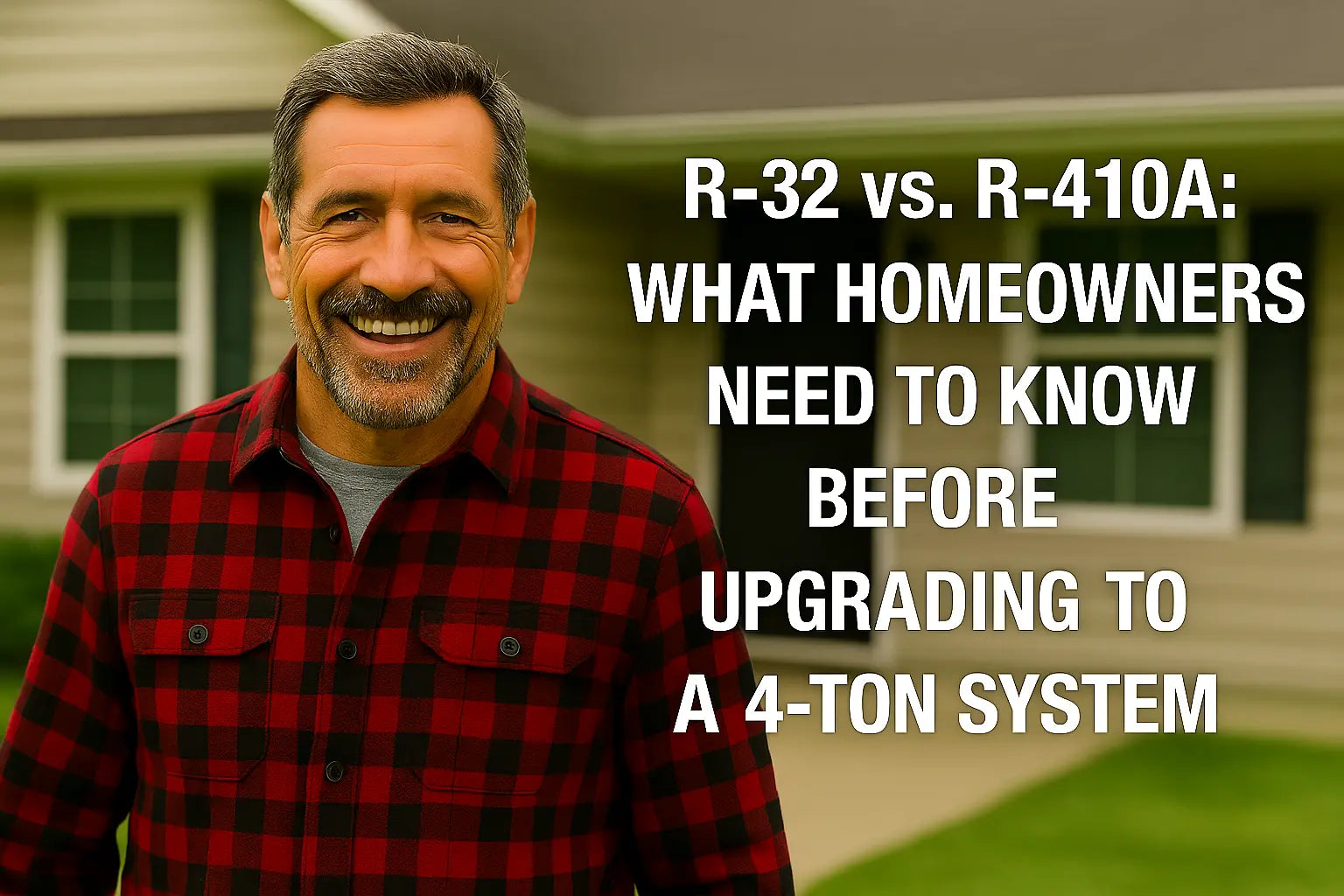Hey Folks — Mike Again 👋
So, you're in the market for a new 4-ton air conditioner — maybe the old one gave out, or maybe you’re finally fed up with that energy-guzzling dinosaur out back. Either way, you’re gonna come across a new acronym: R-32.
Now, you might be used to hearing R-410A, and maybe you’re wondering:
“What the heck is R-32, and should I even care?”
Short answer: yes, you should. Especially if you’re thinking long-term.
Let’s walk through R-32 vs. R-410A — side by side — and I’ll explain what the switch means, why manufacturers are ditching R-410A, and how it affects your next 4-ton install.
Why the Switch from R-410A?
First off — the industry didn’t just wake up and decide to use a new refrigerant for fun. R-410A is being phased down because of its global warming potential (GWP).
-
R-410A has a GWP of 2,088
-
R-32 has a GWP of 675 (about 70% lower)
The EPA, under the AIM Act, is pushing HVAC manufacturers to move toward lower-GWP refrigerants. R-32 is a front-runner, and most major brands — like Goodman, Carrier, and LG — are now rolling out R-32 units nationwide.
More info on the GWP push here: EPA’s refrigerant phase-down overview.
Efficiency: R-32 Is the Better Performer
Now let’s talk real-world cooling. I’ve worked on both systems, and here’s the deal:
-
R-32 absorbs and releases heat better, so systems can cool faster
-
You get higher SEER2 ratings with smaller compressors
-
R-32 systems often use 20–30% less refrigerant by volume than R-410A
That means you’ll probably see lower utility bills with an R-32 4-ton unit — provided the install is done right.
Carrier did a full side-by-side test of R-32 vs. R-410A performance — read their results right here.
Flammability: Is R-32 Safe?
R-32 is rated A2L, which means:
-
A: Non-toxic
-
2L: Mildly flammable
Now before you panic, let me say this: it’s not like propane. You won’t light the house on fire just by turning on your AC.
That said, it does require:
-
Proper venting in enclosed spaces
-
Leak detectors and sensors (in some jurisdictions)
-
Installer training to meet codes
That’s why you can’t just swap R-32 into an R-410A system — the components and safety systems are different.
Still nervous? Here's a straight-shooting safety breakdown from ASHRAE.
Cost: Upfront vs. Long-Term
Let’s look at the money:
Upfront:
-
R-32 units might cost slightly more upfront, especially the newer 4-ton models with higher SEER2 ratings
-
If your current system uses R-410A, you’ll need a full system replacement — you can’t mix refrigerants
Long-term:
-
R-32 refrigerant is cheaper per pound and requires less volume
-
The system will likely be more efficient, saving you on power bills
-
Future refrigerant availability will favor R-32, not R-410A
Need help comparing your savings? Try this HVAC Energy Calculator from the Energy Star— it’s free and legit.
Availability: The R-32 Surge Has Started
Back in 2022, R-32 systems were pretty rare. Now? Most major manufacturers are either:
-
Already shipping R-32 units
-
Or planning full transitions by 2026
Here’s what I’ve seen firsthand:
-
Daikin, Goodman, and LG have multiple 4-ton R-32 systems in stock
-
Parts and line sets are starting to standardize around R-32-compatible components
-
Distributors are phasing out R-410A in preparation for 2025 compliance milestones
For proof, check out HVAC Insider’s refrigerant forecast.
Can You Still Buy R-410A Systems?
Yes — for now. But it’s a short runway.
Most manufacturers are already sunsetting 410A models. And as supply tightens, R-410A refrigerant prices will rise. So even if you get a “deal” now, you might end up paying more in the long run to maintain it.
And if your 4-ton system needs a major repair down the road? Good luck finding compatible parts and refrigerant by 2027.
Mike’s Tips for Picking the Right 4-Ton System 💡
Here’s what I tell homeowners at the kitchen table:
✅ Choose R-32 if you're buying new — it’s efficient, compliant, and future-proof
✅ Don’t retrofit your 410A system to R-32 — it’s not safe or allowed
✅ Verify local codes — R-32 is approved nationwide, but some cities require extra steps
✅ Look for a system with at least 14.5–15.2 SEER2 — that’s the new sweet spot
✅ Choose an installer who knows R-32 — especially with flare torque, charge levels, and electrical safety
Want a dependable R-32 system? I personally like the lineup from The Furnace Outlet’s 4-ton R-32 collection — good specs, fast shipping, and no fluff.
Final Take: Upgrade Smart, Not Just Fast 💬
Here’s my take: if you’re spending thousands on a new AC, you deserve to know what you’re getting. R-32 is the direction the HVAC world is headed, and when done right, it gives you:
-
Better performance
-
Lower environmental impact
-
Fewer headaches in the long run
Yes, it’s a little different. Yes, it takes some learning. But if you’re upgrading to a 4-ton AC, you might as well go with the refrigerant that’ll still be around in ten years — not one that’s on its way out.
And hey — if you’ve got questions about line sets, permits, or installation? I’ve got guides for those too.
Need to know how to inspect your 4-ton R-32 AC? Visit my guide: The Seasonal Checklist for Homeowners.
Until then — stay cool, stay sharp,
—Mike, your cool HVAC guide 🧊







